An opto-electronic oscillator (OEO) is one of the most popular types of oscillators for generating micro- and millimeter wave signals.
- opto-electronic oscillator
- phase noise
- microwave signal
- millimeter wave signal
1. Introduction
High-precision signal oscillators are needed in a variety of fields such as satellite communications, optical communications, radar applications, radio-over-fiber communications, etc.
[1]
. In its most basic form, an oscillator consists of a resonator and a feedback component. When the Barkhausen conditions are satisfied, the oscillator starts generating the fundamental oscillation signal. An opto-electronic oscillator (OEO) is one of the most popular types of oscillators for generating micro- and millimeter wave signals
. The OEO has a number of optical components such as a laser diode
, an optical fiber
[6]
and a photodiode
[7]
. The electrical components including an electrical bandpass filter and an electrical amplifier are used to complete the feedback loop. The laser of the OEO can be modulated directly, or it can use external modulation with an electro-optic modulator such as a Mach Zehnder modulator (MZM)
[8]
or an electro-absorption modulator
[9]
. A typical externally modulated OEO is shown in
.

Figure 1.
Single-loop opto-electronic oscillator (OEO) with electrical components.
Currently, −163 dBc/Hz at a 6 kHz offset from the carrier for an operating frequency of 10 GHz
[10]
is the lowest phase noise achieved so far. Different types of configurations for the OEO have already been presented in the literature. The dual-loop and multi-loop configurations
, coupled OEO
, injection-locked OEO
, OEO with quality multiplier
[23]
, and OEO with feedback loop
[24]
are some of the well-known configurations. Moreover, optical solutions are possible by adding components such as optical filters
and optical amplifiers
or by adjusting the optical link to achieve an optical gain
[30]
. These are already used to improve the stabilization of the OEO. Since an OEO consisting of such bulky components is very large, some methods to reduce the size of the oscillator device have already been reported. There are several solutions such as using a whispering-gallery-mode resonator (WGMR)
, a ring resonator
, or an electro-absorption modulated laser
[37]
that decrease the size of the OEO. In 2017, a fully integrated OEO was reported in the literature by J. Tang et al.
. In addition, a theoretical and experimental study of the characteristics of an injection-locked OEO was presented and published in several journals
. Recently, a W-band OEO was introduced by G.K.M. Hasanuzzaman et al.
[45]
. The OEO provided a phase noise characteristic of −101 dBc/Hz at a 10 kHz offset from the 94.5 GHz carrier. On the other hand, an opto-electronic parametric oscillator
[46]
was reported in 2020.
There are some more recent developments in the use of OEOs in various applications. One example of this is terahertz (THz) photonic signal generation using an OEO
. Another possible application of an OEO is to use it as a local oscillator (LO) in the central office of a 5G radio access network (RAN)
. The single-loop OEO can be combined with an optical fiber path selector to measure the free spectral range (FSR) and side-mode suppression ratio (SMSR) of the OEO for different lengths of the optical delay line
[53]
. There are other applications of OEOs such as an acoustic sensor
[54]
, low-power radio frequency (RF) signal detection
[55]
, phase-locked loops
, parity time-symmetric OEO
, silicon micro-ring-based OEO
[61]
and linear frequency-modulated waveform generation
[62]
, etc.
Long-term stability and side modes (multimode operation) are the main challenges affecting the stabilization of an OEO. The OEO uses an optical fiber that is mainly affected by the temperature variations in the environment. This leads to fluctuations in the oscillation frequency over time, which is referred to as the frequency drift (in other words, long-term stability). On the other hand, electrical bandpass filters have bandwidth limitations in the micro- and millimeter wave ranges. Electric bandpass filters are used in the oscillator loop to destroy the side modes in the RF spectrum and determine the main mode of the oscillation. Due to the bandwidth limitation of the filter, the side modes are not completely filtered out, and they can therefore be seen in the RF spectrum. The ratio between the fundamental mode and the spurious side modes is called SMSR.
The short-term stability (i.e., phase noise) is mainly based on the length of the delay line of the OEO. The OEO can use a long delay line to achieve the lowest possible phase noise. However, using a long delay line boosts the power of the side modes because the FSR becomes lower, and the side modes are more difficult to filter out due to the bandwidth limitation of the electrical filter. For instance, the use of a 1-km fiber has an FSR of 200 kHz, while a 15 km fiber has an FSR of 13.4 kHz. The relationship between SMSR and phase noise performance of the OEO at different optical lengths is shown in
.
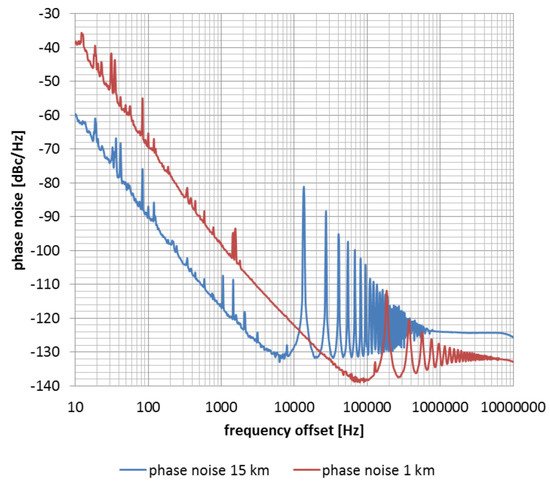
Figure 2.
Comparison of phase noise and side-mode suppression ratio (SMSR) performance of OEO with 1 km and 15 km delay line length
[1]
. Reprinted with permission from ref.
[1]
. Copyright 2015 IEEE.
As can be seen from the experimental results in
, there is a tradeoff between the short-term stability and multimode operation of the OEO. The 1 km OEO has about a 30 dB improvement performance in the SMSR, but the 15 km OEO has a significant improvement in phase noise, which is about 20 dB at 1 kHz and 10 kHz offsets from the carrier.
2. Current Progress of the Common Topologies of the OEO
In this section, the paper focuses on recent advances in the development of OEOs and the main challenges that they face: multimode operation, as well as short-term and long-term stability. In the first subsection, the paper focuses on multimode operation and short-term stability, with long-term stability following this subsection.
2.1. Progress of the OEO toward Lower SMSR and Phase Noise
[63]
[64]
[64]
[65]
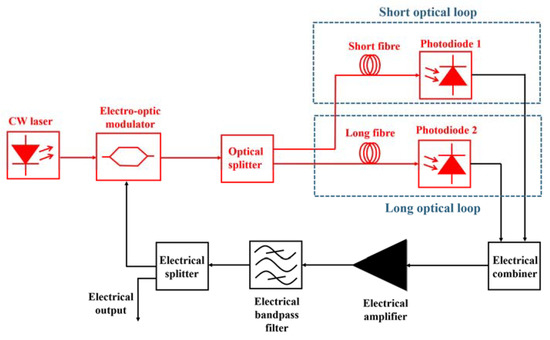
Figure 3.
[63]
[63]
[67]
[67]
[68]
[69]
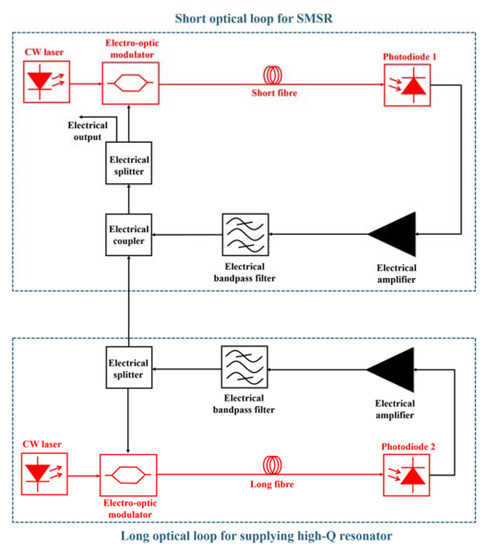
Figure 4.
[63]
[71]
[71]
[72]
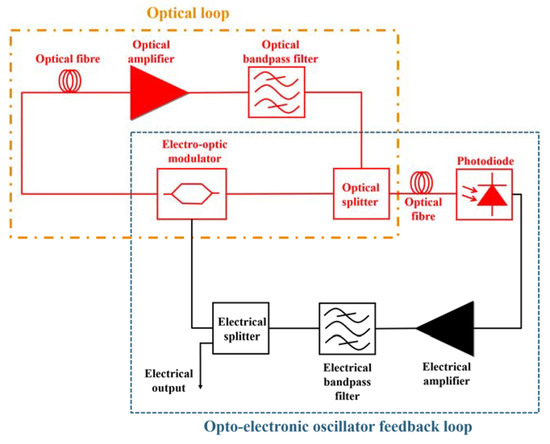
Figure 5.
[73]
[49]
[74]
2.2. Progress of the OEO toward Better Long-Term Stability
[75]
[75]
[75]
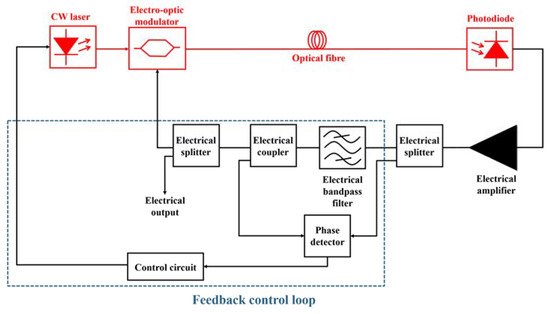
Figure 6.
[77]
[78]
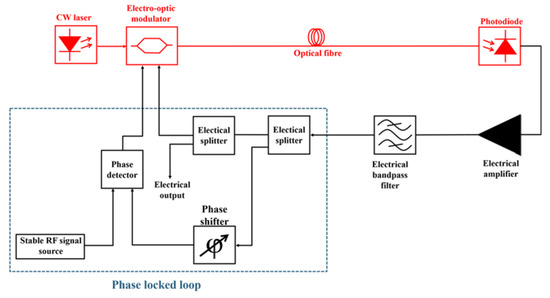
Figure 7.
[79]
−7
2.3. General Overview
In this section of the paper, we would like to compare the performance of different configurations of the OEO in multimode operation: short-term stability (i.e., phase noise) and long-term stability. In the first table, different configurations of the OEO are described by comparing the SMSR and the phase noise.
For
, OEOs with the same or similar frequency were selected (except for the OEO with a high quality opto-electronic filter) to allow a more accurate and scientific comparison of the phase noise in different solutions. However, in theory, the OEO has a stable phase-noise characteristic that is independent of the operating frequency
[1]
, so higher frequencies can be used for the comparison. In the SMSR comparison, the optical delay line length and the bandwidth of the electrical and/or optical filter are more important for the comparison. When considering the phase noise, the injection-locked OEO achieves the best performance among the other solutions. On the other hand, the cascaded micro-wave photonic filter solution achieved a better result in terms of the SMSR.
Table 1.
| Configuration | Optical Delay Line Length | Central Frequency | SMSR | Phase Noise (@10 kHz offset from the carrier) | ||||||||
|---|---|---|---|---|---|---|---|---|---|---|---|---|
| Dual-loop OEO | [64] | 7-core fiber (105 m) |
From 3.5 GHz to 17.1 GHz | 61 dB | −100 dBc/Hz | |||||||
| Injection-locked OEO | [68] | Single-mode fibers (1 km and 0.7 km) |
10 GHz | N/A | −130 dBc/Hz | |||||||
| 15 km | 3 GHz | 0.05 ppm/K | < −130 dBc/Hz | Coupled OEO | [72] | Erbium-doped fiber (4 m) |
10 GHz | 72.5 dB | −123.6 dBc/Hz | |||
| Optical delay stabilization system | [77] | 3 km | 3 GHz | 0.02 ppm/K | −123 dBc/Hz | OEO with high-quality opto-electronic filter | [73] | Dispersion-shifted fiber (3 km) | 29.99 GHz | 83 dB | ||
| OEO with PLL | −113 dBc/Hz | |||||||||||
| [78] | 500 m (Dispersion deduced fiber) |
3 GHz | 6.98 × 10 | −14 | (average time of 1000 s) |
< −100 dBc/Hz | Cascading microwave photonic filter | [49] | Single-mode fibers (2 km and 0.2 km) |
17.33 GHz | 125 dB | −103 dBc/Hz |
| Narrowband microwave laser with dual-loop OEO | [74] | Single-mode fibers (2.5 km and 3 km) |
From 1.85 GHz to 10.24 GHz | 55 dB | −116 dBc/Hz |
In
, different solutions are compared to evaluate the performance of the OEO in terms of long-term stability and phase noise.
Table 2.
The optical delay line system showed good performance in terms of long-term and short-term stability. The phase-noise performance could be improved by using a longer optical fiber. An OEO with a PLL does not have good phase noise performance because a short delay line is used. However, a classic solution such as temperature stabilization has good phase noise performance and short-term stability.
References
- Batagelj, B.; Bogataj, L.; Vidmar, M.; Bostjan, B. Key properties and design issues for an opto-electronic oscillator. In Proceedings of the 2015 17th International Conference on Transparent Optical Networks (ICTON), Budapest, Hungary, 5–9 July 2015; Institute of Electrical and Electronics Engineers (IEEE): New York, NY, USA, 2015; pp. 1–4.
- Liu, A.; Dai, J.; Xu, K. Stable and Low-Spurs Optoelectronic Oscillators: A Review. Appl. Sci. 2018, 8, 2623.
- Yao, X.; Maleki, L. Opto-electronic oscillator and its applications. In International Topical Meeting on Microwave Photonics; MWP 2000 (Cat. No.00EX430); Institute of Electrical and Electronics Engineers (IEEE): New York, NY, USA, 2002; pp. 265–268.
- Tang, J.; Zhu, B.; Zhang, W.; Li, M.; Pan, S.; Yao, J. Hybrid Fourier-domain mode-locked laser for ultra-wideband linearly chirped microwave waveform generation. Nat. Commun. 2020, 11, 1–8.
- Sun, Y.; Zhou, K.; Feng, M.; Li, Z.; Zhou, Y.; Sun, Q.; Liu, J.; Zhang, L.; Li, D.; Sun, X.; et al. Room-temperature continuous-wave electrically pumped InGaN/GaN quantum well blue laser diode directly grown on Si. Light. Sci. Appl. 2018, 7, 13.
- Corcoran, B.; Tan, M.; Xu, X.; Boes, A.; Wu, J.; Nguyen, T.G.; Chu, S.T.; Little, B.E.; Morandotti, R.; Mitchell, A.; et al. Ultra-dense optical data transmission over standard fibre with a single chip source. Nat. Commun. 2020, 11, 1–7.
- Wang, B.; Morgan, J.S.; Sun, K.; Jahanbozorgi, M.; Yang, Z.; Woodson, M.; Estrella, S.; Beling, A.; Yi, X. Towards high-power, high-coherence, integrated photonic mmWave platform with microcavity solitons. Light. Sci. Appl. 2021, 10, 1–10.
- Wang, L.; Zhu, N.; Li, W.; Liu, J. A Frequency-Doubling Optoelectronic Oscillator Based on a Dual-Parallel Mach–Zehnder Modulator and a Chirped Fiber Bragg Grating. IEEE Photon. Technol. Lett. 2011, 23, 1688–1690.
- Liu, M.; Yin, X.; Ulin-Avila, E.; Geng, B.; Zentgraf, T.; Ju, L.; Wang, F.; Zhang, X. A graphene-based broadband optical modulator. Nat. Cell Biol. 2011, 474, 64–67.
- Eliyahu, D.; Seidel, D.; Maleki, L. Phase noise of a high performance OEO and an ultra low noise floor cross-correlation microwave photonic homodyne system. In Proceedings of the 2008 IEEE International Frequency Control Symposium, Honolulu, HI, USA, 18–21 May 2008; IEEE: New York, NY, USA, 2008; pp. 811–814.
- Levy, E.; Horowitz, M.; Okusaga, O.; Menyuk, C.; Carter, G.; Zhou, W. Study of dual-loop optoelectronic oscillators. In Proceedings of the 2009 IEEE International Frequency Control Symposium Joint with the 22nd European Frequency and Time forum, Besancon, France, 20–24 April 2009; IEEE: New York, NY, USA, 2009; pp. 505–507.
- Banky, T.; Horvath, B.; Berceli, T. Optimum configuration of multiloop optoelectronic oscillators. J. Optical Soc. of Am. B. 2006, 23, 1371–1380.
- Shumakher, E.; Eisenstein, G. A Novel Multiloop Optoelectronic Oscillator. IEEE Photon. Technol. Lett. 2008, 20, 1881–1883.
- Wang, W.; Liu, Y.; Du, X.; Yan, Y.; Yu, C.; Chen, X. A Novel Demodulation Method of Fiber Bragg Grating Sensor Array Based on Wavelength-to-time Mapping and Multiloop Optoelectronic Oscillator. In Optical Fiber Communication Conference (OFC) 2020; The Optical Society: Washington, DC, USA, 2020.
- Zhu, D.; Du, T.; Pan, S. A Coupled Optoelectronic Oscillator with Performance Improved by Enhanced Spatial Hole Burning in an Erbium-Doped Fiber. J. Lightw. Technol. 2018, 36, 3726–3732.
- Yao, X.; Davis, L.; Maleki, L. Coupled optoelectronic oscillators for generating both RF signal and optical pulses. J. Lightw. Technol. 2000, 18, 73–78.
- Khayatzadeh, R.; Auroux, V.; Bailly, G.; Fernandez, A.; Llopis, O. Phase noise study based on transfer function in coupled optoelectronic oscillators. In Proceedings of the 2017 International Topical Meeting on Microwave Photonics (MWP), Beijing, China, 23–26 October 2017; Institute of Electrical and Electronics Engineers (IEEE): New York, NY, USA, 2017; pp. 1–4.
- Lelievre, O.; Crozatier, V.; Baili, G.; Nouchi, P.; Dolfi, D.; Morvan, L.; Goldfarb, F.; Bretenaker, F.; Llopis, O. Low phase noise 10 GHz coupled optoelectronic oscillator. In Proceedings of the 2017 Joint Conference of the European Frequency and Time Forum and IEEE International Frequency Control Symposium (EFTF/IFCS), Besancon, France, 9–13 July 2017; Institute of Electrical and Electronics Engineers (IEEE): New York, NY, USA, 2017; pp. 493–494.
- Peng, H.; Du, H.; Guo, R.; Xu, Y.; Zhang, C.; Chen, J.; Chen, Z. Highly Stable and Low Phase Noise 10 GHz RF Signal Generation Based on a Sub-Harmonic Injection Locked Optoelectronic Oscillator. In Proceedings of the 2018 IEEE International Frequency Control Symposium (IFCS), Olympic Valley, CA, USA, 21–24 May 2018; Institute of Electrical and Electronics Engineers (IEEE): New York, NY, USA, 2018; pp. 1–3.
- Lee, K.; Kim, J.; Choi, W. Injection-Locked Hybrid Optoelectronic Oscillators for Single-Mode Oscillation. IEEE Photon. Technol. Lett. 2008, 20, 1645–1647.
- Hudek, K.; Hati, A.; Howe, D.; Nelson, C.; Zhou, W. Further Examination of the Injection-Locked Dual Optoelectronic Oscillator. In Proceedings of the 2007 IEEE International Frequency Control Symposium Joint with the 21st European Frequency and Time Forum, Geneva, Switzerland, 29 May–1 June 2007; Institute of Electrical and Electronics Engineers (IEEE): New York, NY, USA, 2007; pp. 796–800.
- Lee, K.-H.; Kim, J.-Y.; Choi, W.-Y.; Kamitsuna, H.; Ida, M.; Kurishima, K. Low-Cost Optoelectronic Self-Injection-Locked Oscillators. IEEE Photon. Technol. Lett. 2008, 20, 1151–1153.
- Bogataj, L.; Vidmar, M.; Batagelj, B. Opto-Electronic Oscillator with Quality Multiplier. IEEE Trans. Microw. Theory Tech. 2016, 64, 1–6.
- Bogataj, L.; Vidmar, M.; Batagelj, B. A Feedback Control Loop for Frequency Stabilization in an Opto-Electronic Oscillator. J. Lightw. Technol. 2014, 32, 3690–3694.
- Bagnell, M.; Delfyett, P.J. Optoelectronic oscillator using an ultra-high finesse Fabry-Perot etalon as a photonic filter for low phase noise at high oscillating frequencies. 2013 IEEE Int. Top. Meet. Microw. Photonics 2013, 56–59.
- Ozdur, I.; Mandridis, D.; Hoghooghi, N.; Delfyett, P.J. Low Noise Optically Tunable Opto-Electronic Oscillator with Fabry–Perot Etalon. J. Lightw. Technol. 2010, 28, 3100–3106.
- Ozdur, I.; Mandridis, D.; Hoghooghi, N.; Delfyett, P.J. Tunable opto-electronic oscillator with an intracavity Fabry-Perot etalon. In Proceedings of the 2010 23rd Annual Meeting of the IEEE Photonics Society, Denver, CO, USA, 20–11 November 2010; IEEE: New York, NY, USA, 2010.
- Zhou, W.; Okusaga, O.; Nelson, C.; Howe, D.; Carter, G.M. 10 GHz dual loop opto-electronic oscillator without RF-amplifiers. Integr. Optoelectron. Devices 2008 2008, 6897, 68970Z.
- Huang, N.; Li, M.; Deng, Y.; Zhu, N.H. Optical Pulse Generation Based on an Optoelectronic Oscillator with Cascaded Nonlinear Semiconductor Optical Amplifiers. IEEE Photon. J. 2014, 6, 1–8.
- Nelson, C.; Hati, A.; Howe, D.; Zhou, W. Microwave Optoelectronic Oscillator with Optical Gain. In Proceedings of the 2007 IEEE International Frequency Control Symposium Joint with the 21st European Frequency and Time Forum, Geneva, Switzerland, 29 May–1 June 2007; Institute of Electrical and Electronics Engineers (IEEE): New York, NY, USA, 2007; pp. 1014–1019.
- Nguimdo, R.M.; Saleh, K.P.; Coillet, A.; Lin, G.; Martinenghi, R.; Chembo, Y.K. Phase Noise Performance of Optoelectronic Oscillators Based on Whispering-Gallery Mode Resonators. IEEE J. Quantum Electron. 2015, 51, 1–8.
- Volyanskiy, K.; Salzenstein, P.; Tavernier, H.; Pogurmirskiy, M.; Chembo, Y.K.; Larger, L. Compact optoelectronic microwave oscillators using ultra-high Q whispering gallery mode disk-resonators and phase modulation. Opt. Express 2010, 18, 22358–22363.
- Savchenkov, A.A.; Ilchenko, V.S.; Byrd, J.; Liang, W.; Eliyahu, D.; Matsko, A.B.; Seidel, D.; Maleki, L. Whispering-gallery mode based opto-electronic oscillators. In Proceedings of the 2010 IEEE International Frequency Control Symposium, Newport Beach, CA, USA, 1–4 June 2010; IEEE: New York, NY, USA, 2010; pp. 554–557.
- Merrer, P.-H.; Saleh, K.; Llopis, O.; Berneschi, S.; Cosi, F.; Conti, G.N. Characterization technique of optical whispering gallery mode resonators in the microwave frequency domain for optoelectronic oscillators. Appl. Opt. 2012, 51, 4742–4748.
- Saleh, K.; Bouchier, A.; Merrer, P.H.; Llopis, O.; Cibiel, G. Fiber ring resonator based opto-electronic oscillator: Phase noise optimisation and thermal stability study. SPIE-Intl. Soc. Optical. Eng. 2011, 7936, 79360A.
- Chen, J.; Zheng, Y.; Xue, C.; Zhang, C.; Chen, Y. Filtering effect of SiO2 optical waveguide ring resonator applied to optoelectronic oscillator. Opt. Express 2018, 26, 12638–12647.
- Zhou, P.; Pan, S.; Zhu, D.; Guo, R.; Zhang, F.; Zhao, Y. A Compact Optoelectronic Oscillator Based on an Electroabsorption Modulated Laser. IEEE Photon. Technol. Lett. 2013, 26, 86–88.
- Tang, J.; Hao, T.; Li, W.; Zhu, N.; Li, M.; Domenech, D.; Banos, R.; Munoz, P.; Capmany, J. An integrated optoelectronic oscillator. In Proceedings of the 2017 International Topical Meeting on Microwave Photonics (MWP), Beijing, China, 23–26 October 2017; IEEE: New York, NY, USA, 2017; pp. 1–4.
- Hao, T.; Liu, Y.; Tang, J.; Cen, Q.; Li, W.; Zhu, N.; Dai, Y.; Capmany, J.; Yao, J.; Li, M. Recent advances in optoelectronic oscillators. Adv. Photon. 2020, 2, 044001.
- Banerjee, A.; De Britto, L.A.D.; Pacheco, G.M. A Theoretical and Experimental Study of Injection-Locking and Injection-Pulling for Optoelectronic Oscillators Under Radio Frequency Signal Injection. J. Lightw. Technol. 2019, 38, 1210–1220.
- Banerjee, A.; De Britto, L.A.D.; Pacheco, G.M. Analysis of Injection Locking and Pulling in Single-Loop Optoelectronic Oscillator. In IEEE Transactions on Microwave Theory and Techniques; IEEE: New York, NY, USA, 2019; Volume 67, pp. 2087–2094.
- Banerjee, A.; Sarkar, J.; De Britto, L.A.D.; Pacheco, G.M.; Das, N.R. On the Transient Behavior of Single-Loop Optoelectronic Oscillators Under RF Injection-Locking. IEEE J. Quantum Electron. 2020, 56, 1–13.
- Banerjee, A.; De Britto, L.A.D.; Pacheco, G.M. Study of injection-locking and injection-pulling in injection-locked optoelectronic oscillator under radio frequency signal injection. Opt. Eng. 2019, 58, 58.
- Banerjee, A.; De Britto, L.A.D.; Pacheco, G.M. Analysis of phase noise in self-injection-locked optoelectronic oscillator. Optik 2020, 223, 165475.
- Hasanuzzaman, G.K.M.; Iezekiel, S.; Kanno, A. W-Band Optoelectronic Oscillator. IEEE Photon. Technol. Lett. 2020, 32, 771–774.
- Hao, T.; Cen, Q.; Guan, S.; Li, W.; Dai, Y.; Zhu, N.; Li, M. Optoelectronic parametric oscillator. Lightw. Sci. Appl. 2020, 9, 9.
- Hasanuzzaman, G.; Shams, H.; Renaud, C.C.; Mitchell, J.; Iezekiel, S. Photonic THz Generation using Optoelectronic Oscillator-driven Optical Frequency Comb Generator. In Proceedings of the 2018 International Topical Meeting on Microwave Photonics (MWP), Toulouse, France, 22–25 October 2018; Institute of Electrical and Electronics Engineers (IEEE): New York, NY, USA, 2018; pp. 1–4.
- Hasanuzzaman, G.K.M.; Shams, H.; Renaud, C.C.; Mitchell, J.; Seeds, A.J.; Iezekiel, S. Tunable THz Signal Generation and Radio-Over-Fiber Link Based on an Optoelectronic Oscillator-Driven Optical Frequency Comb. J. Lightw. Technol. 2020, 38, 5240–5247.
- Hasanuzzaman, G.K.M.; Shams, H.; Renaud, C.C.; Mitchell, J.; Seeds, A.J.; Iezekiel, S. Cascaded Microwave Photonic Filters for Side Mode Suppression in a Tunable Optoelectronic Oscillator applied to THz Signal Generation & Transmission. IEEE Photon. J. 2021, 13, 1–11.
- Ilgaz, M.A.; Batagelj, B. Opto-electronic oscillator in the mm-W range for 5G wireless and mobile networks: Design challenges and possible solutions. In Proceedings of the 2017 International Conference on Optical Network Design and Modeling (ONDM), Budapest, Hungary, 15–18 May 2017; IEEE: New York, NY, USA, 2017.
- Ilgaz, M.A.; Batagelj, B. Application of an Opto-Electronic Oscillator in 5G Mobile and Wireless Networks with a Low Frequency Drift, a High Side-Modes-Suppression Ratio and without a Power Penalty due to Chromatic Dispersion. In Proceedings of the 2018 European Conference on Networks and Communications (EuCNC), Ljubljana, Slovenia, 18–21 June 2018; Institute of Electrical and Electronics Engineers (IEEE): New York, NY, USA, 2018; pp. 388–392.
- Ilgaz, M.A.; Batagelj, B. Using Tunable Dispersion-Compensated Modules to Overcome the Power Penalty of a Millimeter-Wave Opto-Electronic Oscillator Signal that is Distributed via a Passive Optical Network for 5G Networks. In Proceedings of the 2018 11th International Symposium on Communication Systems, Networks & Digital Signal Processing (CSNDSP), Budapest, Hungary, 18–20 July 2018; IEEE: New York, NY, USA, 2018; pp. 1–6.
- Ilgaz, M.A.; Batagelj, B. Measurement of the Free Spectral Range and the Side-Modes Suppression Ratio of a 9.3-GHz Single-Loop Opto-Electronic Oscillator by Fiber Path Selector. In Proceedings of the 2018 26th Telecommunications Forum (TELFOR), Belgrade, Serbia, 20–21 November 2018; Institute of Electrical and Electronics Engineers (IEEE): New York, NY, USA, 2018; pp. 1–4.
- Okusaga, O.; Pritchett, J.; Sorenson, R.; Zhou, W.; Berman, M.; Cahill, J.; Carter, G.M.; Menyuk, C.R. The OEO as an acoustic sensor. In Proceedings of the 2013 Joint European Frequency and Time Forum & International Frequency Control Symposium (EFTF/IFC), Prague, Czech Republic, 21–25 July 2013; Institute of Electrical and Electronics Engineers (IEEE): New York, NY, USA, 2013; pp. 66–68.
- Shao, Y.; Han, X.; Ye, Q.; Zhu, B.; Dai, Y.; Wang, C.; Zhao, M. Low-Power RF Signal Detection Using a High-Gain Tunable OEO Based on Equivalent Phase Modulation. J. Lightw. Technol. 2019, 37, 5370–5379.
- Zhang, L.; Poddar, A.K.; Rohde, U.L.; Daryoush, A S. Self-injection locked phase-locked loop OEO. In IEEE MTT-S International Microwave and RF Conference; IEEE: New York, NY, USA, 2013; pp. 1–4.
- Peng, H.; Liu, N.; Li, Y.; Xie, X.; Chen, Z. Low Phase Noise and Highly Stable Optoelectronic Oscillator by Using Frequency-Multiplying Phase Locked Loop. In Proceedings of the 2020 Joint Conference of the IEEE International Frequency Control Symposium and International Symposium on Applications of Ferroelectrics (IFCS-ISAF), Keystone, CO, USA, 19–23 July 2020; Institute of Electrical and Electronics Engineers (IEEE): New York, NY, USA, 2020; pp. 1–2.
- Zhang, L.; Poddar, A.K.; Rohde, U.L.; Daryoush, A.S. Comparison of Optical Self-Phase Locked Loop Techniques for Frequency Stabilization of Oscillators. IEEE Photon. J. 2014, 6, 1–15.
- Zhang, J.; Yao, J. Parity-time–symmetric optoelectronic oscillator. Sci. Adv. 2018, 4, eaar6782.
- Liu, Y.; Hao, T.; Li, W.; Capmany, J.; Zhu, N.; Li, M. Observation of parity-time symmetry in microwave photonics. Light. Sci. Appl. 2018, 7, 1–9.
- Do, P.T.; Alonso-Ramos, C.; Le Roux, X.; Le Doux, I.; Journet, B.; Cassan, E. Wideband tunable microwave signal generation in a silicon-micro-ring-based optoelectronic oscillator. Sci. Rep. 2020, 10, 1–9.
- Zhou, P.; Zhang, F.; Pan, S. Generation of Linear Frequency-Modulated Waveforms by a Frequency-Sweeping Optoelectronic Oscillator. J. Lightw. Technol. 2018, 36, 3927–3934.
- Hao, T.; Tang, J.; Domenech, D.; Li, W.; Zhu, N.H.; Capmany, J.; Li, M. Toward Monolithic Integration of OEOs: From Systems to Chips. J. Lightw. Technol. 2018, 36, 4565–4582.
- Huang, L.; Deng, L.; Fu, S.; Tang, M.; Cheng, M.; Zhang, M.; Liu, D. Stable and Compact Dual-Loop Optoelectronic Oscillator Using Self-Polarization-Stabilization Technique and Multicore Fiber. J. Lightw. Technol. 2018, 36, 5196–5202.
- Li, M.; Li, L.; Zhang, J.; Yao, J. Dual-Loop and Parity-Time-Symmetric Optoelectronic Oscillator with Strong Sidemode Suppression. In Proceedings of the 2020 International Topical Meeting on Microwave Photonics (MWP), Matsue, Japan, 24–26 November 2020; IEEE: New York, NY, USA, 2020.
- Zhou, W.; Blasche, G. Injection-locked dual opto-electronic oscillator with ultra-low phase noise and ultra-low spurious level. IEEE Trans. Microw. Theory Tech. 2005, 53, 929–933.
- Xu, W.; Yang, C.; Wang, Z.; Zhao, W. Tunable Low-Spurious Heterodyne-Dual-Injection-Locked Optoelectronic Oscillator. In Proceedings of the 2019 International Topical Meeting on Microwave Photonics (MWP), Ottawa, ON, Canada, 7–10 October 2019; Institute of Electrical and Electronics Engineers (IEEE): New York, NY, USA, 2019; pp. 1–3.
- Peng, H.; Guo, R.; Du, H.; Xu, Y.; Zhang, C.; Chen, J.; Chen, Z. Low Phase Noise 20 GHz Microwave Frequency Divider Based on a Super-Harmonic Injection Locked Optoelectronic Oscillator. In Proceedings of the 2018 IEEE International Frequency Control Symposium (IFCS), Olympic Valley, CA, USA, 21–24 May 2018; Institute of Electrical and Electronics Engineers (IEEE): New York, NY, USA, 2018; pp. 1–3.
- Shi, M.; Yi, L.; Hu, W. High-Resolution Brillouin Optoelectronic Oscillator Using High-Order Sideband Injection-Locking. IEEE Photon. Technol. Lett. 2019, 31, 513–516.
- Yao, X.S.; Maleki, L. Dual microwave and optical oscillator. Opt. Lett. 1997, 22, 1867–1869.
- Ly, A.; Auroux, V.; Khayatzadeh, R.; Gutierrez, N.; Fernandez, A.; Llopis, O. Highly Spectrally Pure 90-GHz Signal Synthesis Using a Coupled Optoelectronic Oscillator. IEEE Photon. Technol. Lett. 2018, 30, 1313–1316.
- Zhu, D.; Wei, Z.; Du, T.; Pan, S. A coupled optoelectronic oscillator based on enhanced spatial hole burning effect. In Proceedings of the 2016 IEEE International Topical Meeting on Microwave Photonics (MWP), Long Beach, CA, USA, 31 October–3 November 2016.
- Liu, A.; Liu, J.; Dai, J.; Dai, Y.; Yin, F.; Li, J.; Zhou, Y.; Zhang, T.; Xu, K. Spurious Suppression in Millimeter-Wave OEO With a High- Q Optoelectronic Filter. IEEE Photon. Technol. Lett. 2017, 29, 1671–1674.
- Yang, Y.-D.; Liao, M.-L.; Han, J.-Y.; Weng, H.-Z.; Xiao, J.-L.; Huang, Y.-Z. Narrow-Linewidth Microwave Generation by Optoelectronic Oscillators with AlGaInAs/InP Microcavity Lasers. J. Lightw. Technol. 2018, 36, 4379–4385.
- Eliyahu, D.; Sariri, K.; Kamran, A.; Tokhmakhian, M. Improving short and long term frequency stability of the opto-electronic oscillator. In Proceedings of the 2002 IEEE International Frequency Control Symposium and PDA Exhibition, Cat. No.02CH37234. New Orleans, LA, USA, 29–31 May 2002; Institute of Electrical and Electronics Engineers (IEEE): New York, NY, USA, 2003; pp. 580–583.
- Bogataj, L.; Vidmar, M.; Batagelj, B. Improving the Side-mode Suppression Ratio and Reducing the Frequency Drift in an Opto-Electronic Oscillator With a Feedback Control Loop and Additional Phase Modulation. J. Lightw. Technol. 2015, 34, 885–890.
- Bogataj, L.; Tratnik, J.; Batagelj, B.; Dragonja, U. A highly stable OEO using a multi-purpose optical-delay stabilization system. In Proceedings of the 2017 Joint Conference of the European Frequency and Time Forum and IEEE International Frequency Control Symposium (EFTF/IFCS), Besancon, France, 9–13 July 2017; Institute of Electrical and Electronics Engineers (IEEE): New York, NY, USA, 2017; pp. 486–488.
- Zhang, Y.; Hou, D.; Zhao, J. Long-Term Frequency Stabilization of an Optoelectronic Oscillator Using Phase-Locked Loop. J. Lightw. Technol. 2014, 32, 2408–2414.
- Tseng, W.-H.; Feng, K.-M. Enhancing long-term stability of the optoelectronic oscillator with a probe-injected fiber delay monitoring mechanism. Opt. Express 2012, 20, 1597–1607.
